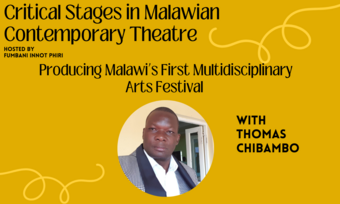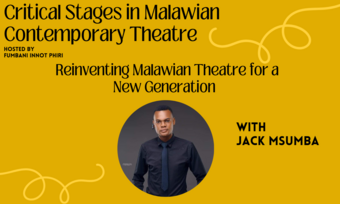Interview with Finegan Kruckemeyer
Do you have a "tribe?"
My first and most important tribe is a familial one, because I love these people and have crossed an ocean with these people and together we’ve settled in a land that has (as far as I know) no other Kruckemeyers. And so this mother and father and brother and sister and niece and now wife (and one who would choose to take on that name!)—with our shared history and unfolding future—are a pretty core thing in my life.
Beyond this, my social and creative tribe is, quite intentionally, a non-theater one. This isn’t to say that theater people don’t exist within it, but its make-up is defined not by a shared profession, but rather by shared geography. Eight years ago my wife Essie and I moved to Hobart, the capital of the island state of Tasmania. It is slow and beautiful and sits above a river and beneath a mountain. It’s a city that’s wonderful in its uncityness.
And the community we’ve found within it (made up of people from innumerable professions and demographics) have become very important to us both. Both successes and trials feel like shared things, and as such, these people feel like the perfect touchstones for my work—they are perfectly representative of any audience and so they have become it, time and time again. Any new play is shown first to them, in a warm lounge room with lots of red wine. My friends’ café is where I go to write when my office can’t hold a particular idea. If I need help with diving terminology, I ask a diver. If a character has to make a certain meal, I ask a chef to invent it. And when I unveil a new play for children, then my friends bring theirs to the theater, and the kids tell me if it went alright or not.
How do you begin work on a new piece?
I’m very bad at planning ahead, so in its simplest form, I just sit at my laptop with a cup of tea and begin writing. I’ve found that a blank screen is the worst thing to meet when seeking out ideas, so I just write anything and slowly the physical act of writing becomes the key to unlocking those ideas that need to be written. Always, the notion of an audience is in my mind, so I don’t lose sight of the ones that the play is for. And never do I have in my mind a sense of the how, in terms of how an idea on the page will be realised—that’s completely for the company to discover.
Usually the first thing to appear is a character who is very blurry around the edges. I’ll start by letting them speak and hearing what they say, what seems to be their mission or desire, and what might be impeding that. Then from this opening gambit, I try to recognize features of their landscape, of the world in which they live, and sketch that. Then if I now know that this person exists in this world, and with this drive for something, I’ll invent a person they might encounter (be they friend or foe) and slowly build a population out that way. Eventually I give them momentum and set them off on some adventure or other (it can be around a world, or a kitchen table, no matter), and then just try to problem-solve along the way.
The following is a clip of Finegan's piece, The Tragical Life of Cheesboy:
Do you consider yourself a maker of work for children?
No. I really just enjoy writing stories, and if a play is for a child audience, then I’ll make the protagonist a child and make the touchstones of the character’s world ones that are recognizable to children. But the emotional stakes will be just the same as those in an adult play. The sense of trepidation, the sense of uncertainty around outcomes, will be there just as much.
It’s true that most of the work I write these days is for children. But if I get too comfortable in the notion of being a children’s writer, then I fear I would find myself editing my creativity so as to create children’s stories, as opposed to just stories. And I think what child audiences deserve are stories, with as little judgment around this as possible. Then they can make their own minds up whether a particular one connected with them or not, just as an adult audience is entitled to.
What other theater artists or companies inspire you now or shaped your work in the past?
It’s a bit sad, as one of them actually just passed away. Maurice Sendak I think was a beautiful creator of works for children, brave and uncompromising works with emotional scores that resonated with many, both young and old. That great skill of his to use simplicity (few words, choice images) to evoke so much is quite amazing. A tattoo of Mickey’s dough airplane from In the Night Kitchen sits on my right arm.
The old, dark fairy tales are great for reminding us what children could handle once, and for balancing fantastical occurrences with astute adherence to structure and sound storytelling. I like referencing some of their conventions in new works I write.
Theater Artemis, Velo Theater, Grüppe 38, Compagnie Rodisio, Les Métamorphoses Singulières are children’s theater companies that have shown me work that would be wonderful in any audience’s eyes.
Tell me about the piece you're making with/for Trusty Sidekick? Can you describe it? How did you come to work with them?
It started in the nicest way—by making friends with someone and talking about work together. I had a play on at the New Victory in New York, and Jonathan Shmidt works in the education department there. He emailed me and we made friends, and then when I came to the city we hung out. He was just founding a new theater company, and I had a new idea for a play that lacked a home. So I wrote this play about two boys separated by vast distances, who set off on journeys to discover how each other’s world works. And then we applied for New Visions/New Voices and were accepted—and now these two boys separated by vast distances are setting off on journeys to discover how this new contrived play world works! The more commissions I do, the more I learn that projects borne from friendships generate the best results. It’s a very nice lesson to learn.
Does the work you make now refract in any way with your own childhood—are you making things that capture something about your childhood or are you making things you wish you'd seen as a child? Or is it driven by who you are now and what you see and experience at present?
I actually try quite pointedly to avoid any notions of autobiography in my work, as it can: lead to cutting corners (because you have an unfair level of subjectivity not shared by an audience); constrain ideas (the territory of the truth comes with too many obligations about how to present it) and; not be all that interesting.
That said, of course I think back to myself as a kid when imagining how a child audience might respond to something. And I remember the Irish countryside of my youth when thinking about countryside. When I think of love, I think of my loves. For sadness, I think of my sadnesses. And for a family dinner, I remember my own. But these are emotions which are inherently universal, and pretty quickly we have to shift from telling any one person’s story, to telling a story which resonates with all.
What drives you crazy as an artist?
The notion that child audiences are only allowed to witness happiness, or that works for teenagers must all be morose and angsty. Every audience deserves a palette of all the emotions I think—bring on the childhood pathos and the teenage laughter, I say.
The notion that child audiences are only allowed to witness happiness, or that works for teenagers must all be morose and angsty. Every audience deserves a palette of all the emotions I think—bring on the childhood pathos and the teenage laughter, I say.
Much theater I’ve seen at the moment (particularly Australian adult work) offers tragedy, but no redemption. I find tragedy (meet a character, acknowledge what they love, take it away) affecting but too easy. Take us on that journey and then offer the redemptive epiphany (not in all stories, but sometimes), and that is the magic trick that makes a work sing.
A lot of focus on the how and not enough on the what—artists I speak with having great notions about how a story might be told, what technology will be used, where it will tour. But forgetting the significance of the what—the story itself which humans are innately drawn to. Maybe it’s a writerly bias, but I think story could deserve a bit more celebrating at the moment.
Do you have a "dream" project?
I’m mid-dream at the moment actually! Recently I received the most amazing professional gift, in the form of a Sidney Myer Creative Fellowship, which provides me with two years’ wages to write some non-commissioned works alongside my work ones. In this time, I’m imagining creating five or six interwoven stories, whereby a peripheral character in one (who departs the tale once their work is done) becomes the protagonist in another. In this way (and across various mediums—plays, books, possibly film), a meta-narrative is created which would allow audiences to witness just one work (in itself a complete thing) or a number, with recognizable characters moving throughout.










Comments
The article is just the start of the conversation—we want to know what you think about this subject, too! HowlRound is a space for knowledge-sharing, and we welcome spirited, thoughtful, and on-topic dialogue. Find our full comments policy here
While it was the one reading I missed this weekend :-( I heard that "The Boy at the Edge of Everything" was an incredble piece. Wishing you all the best on its future.
"The notion that child audiences are only allowed to witness happiness, or that works for teenagers must all be morose and angsty. Every audience deserves a palette of all the emotions I think—bring on the childhood pathos and the teenage laughter, I say."
Absolutely.
I'm hoping Jonathan Schmidt will talk about his work with Fin and share some of what he's making happen at his new theatre in New York, Trusty Sidekick. And I hop, Fin and Joanathan, that the development of the new play, and your time together at New Vision/New Voices last weekend was a great next step in the adventure of your collaboration.